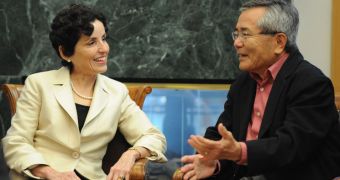Officials with the Nobel Committee announced that the 2010 Nobel Prize in Chemistry will go to jointly researchers who conducted work in creating a method for build complex organic molecules.
The technique has numerous applications, ranging from pharmaceutical manufacturing to the electronics industry. The Committee made the announcement on Wednesday, October 6.
The Prize goes to scientists Richard F. Heck, Ei-ichi Negishi and Akira Suzuki “for palladium-catalyzed cross couplings in organic synthesis,” the official announcement reads.
Richard Heck is based at the University of Delaware in Newark, while scientist Akira Suzuki holds an appointment at the Hokkaido University in Sapporo, Japan.
Negishi is the Herbert C. Brown Distinguished Professor of Chemistry at the Purdue University, in the United States. The three experts will share the $1.5 million award that comes with the Nobel Prize.
“Ei-ichi Negishi's work in organic molecules is groundbreaking and inspiring, especially in its application for improving medicines and impacting lives,” says Purdue President France A. Córdova.
“We are very proud that he has been bestowed with this highest honor. We congratulate professor Negishi and celebrate this great accomplishment,” he goes on to say.
The official adds that he and other professors at the university are proud of the contributions that their colleague brought to the field of science, and that they congratulate him on his recogniztion.
Basically Negishi's work revolves around developing simple, cost-effective ways of creatingcomplex organic compounds, which have a myriad of applications today.
The expert managed to develop a series of metal-based reactions called palladium-catalyzed cross-coupling that made this a tangible reality.
Some of the applications that were made possible by this work include the creation of fluorescent markings for DNA sequencing, thin LED displays, and advanced drug manufacturing.
“Catalysts are not lost as they spur a chemical reaction, they are recycled and can be used over and over again,” the expert himself says.
“These transition metals are very expensive, but when they can be used millions to billions of times, it dramatically reduces the cost and makes the mass manufacturing of special, complex materials practical,” he adds.
The Nobel Prizes will be awarded during ceremonies on December 10 in Stockholm and Oslo.

 14 DAY TRIAL //
14 DAY TRIAL //